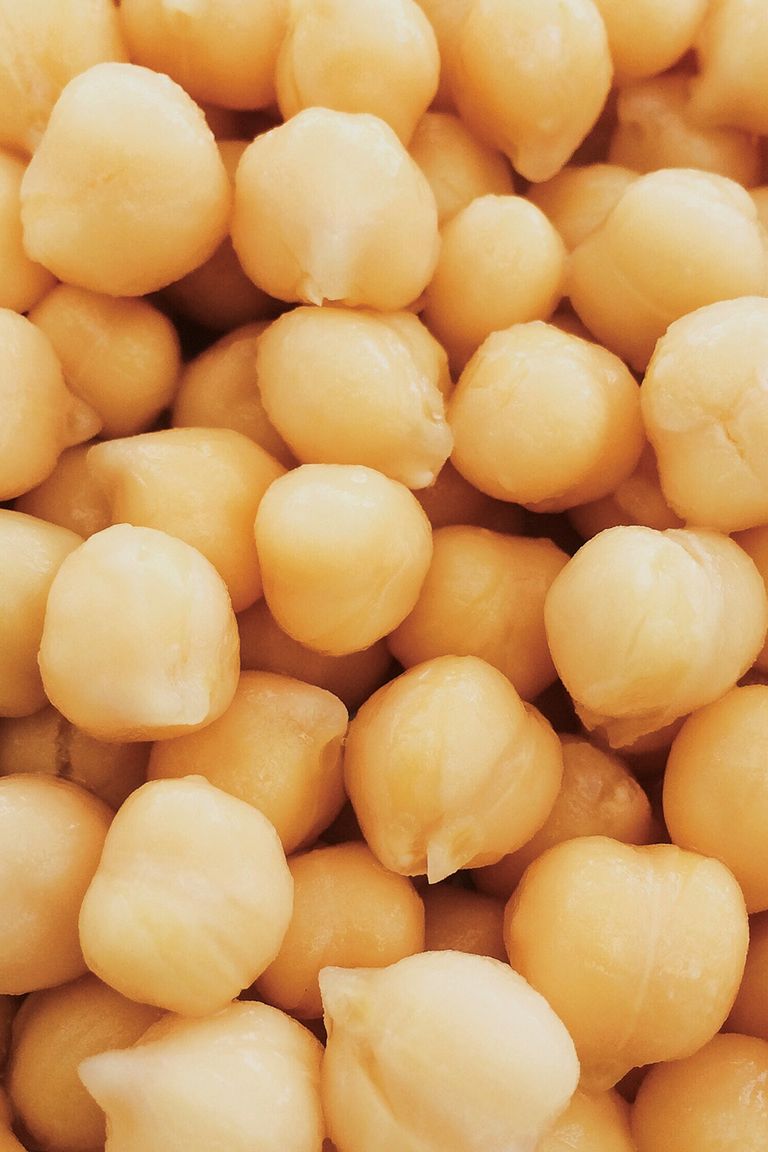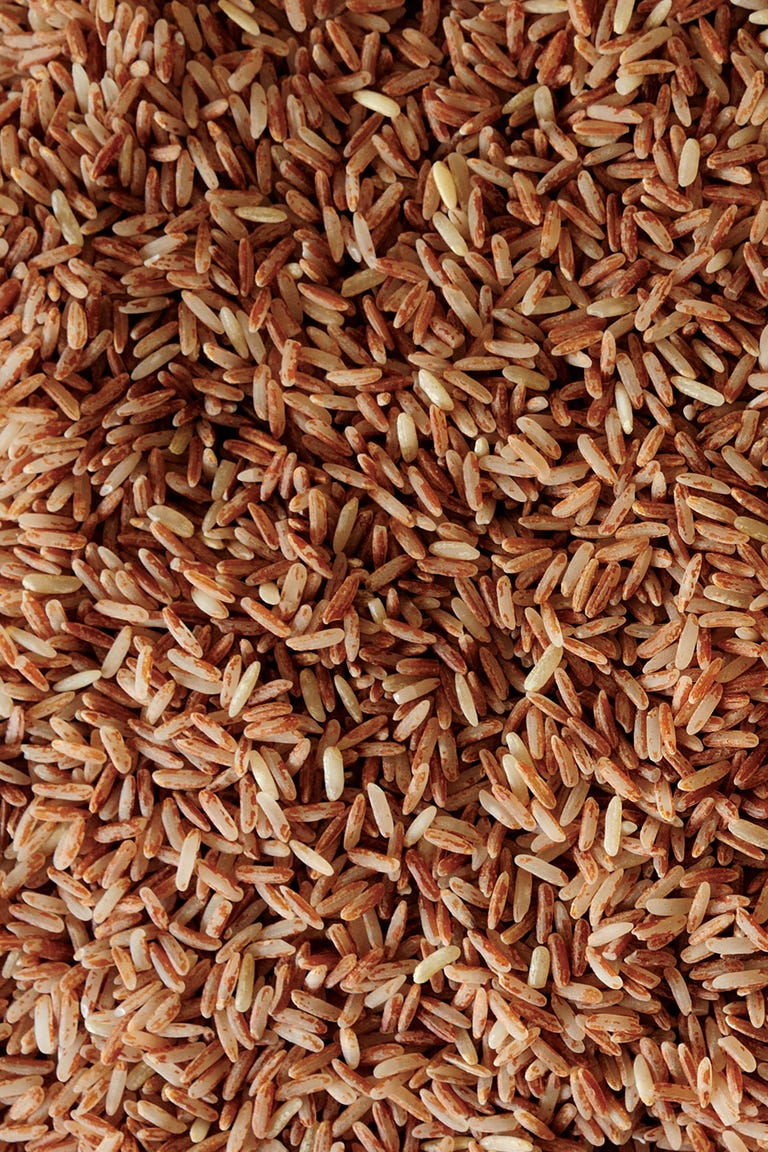

It’s become totally normal to order burgers without buns, eat meatballs on a pile of zoodles, and even to (gasp!) make pizza with cauliflower. Because apparently carbs are the enemy.
However, complex carbohydrates—starches made up of long chains of sugar molecules—are considered “good carbs” because they take longer to digest and thus don’t spike blood sugars as quickly as more simple ones, says Ha Nguyen, R.D.N., of Yummy Body Nutrition.
While simple carbs like juice, ice cream, candy, and white bread are okay in moderation, your best bet is to make sure your carb intake comes mostly from complex carbs like whole grains, legumes, and starchy veggies. To make things super-easy, keep this complex carbs list on hand for your next trip to the grocery store.

Getty Images
Chickpeas
One cup of chickpeas packs an impressive 11 grams of protein and 10 grams of fiber (one third of the minimum recommended daily fiber intake, which is about 30 grams). They’re also rich in calcium and phosphate, both of which are important for bone health.
Per serving (1 cup, cooked or canned): 270 calories, 4 g fat (0 g saturated), 45 g carbs, 8 g sugar, 11 mg sodium, 13 g fiber, 15 g protein.

Getty Images
Old-fashioned oats
Old-fashioned oats (also called rolled oats) are packed with manganese, iron, folate, B vitamins, and other important nutrients. Regular intake of the soluble fiber in oats has also been shown to help reduce LDL cholesterol (that’s the bad kind).
Per serving (1/2 cup, dry): 150 calories, 3 g fat (0 g saturated), 27 g carbs, 1 g sugar, 0 mg sodium, 4 g fiber, 5 g protein.

Getty Images
Multigrain hot cereal
If you’re looking to switch up your oatmeal routine without straying completely, try a multigrain hot cereal made with oats, plus other grains like barley, rye, triticale, millet, and more. More grains means a bigger variety of nutrients, which is key to an overall healthy diet.
Per serving (1/2 cup, dry): 160 calories, 3 g fat (0 g saturated), 30 g carbs, 1 g sugar, 80 mg sodium, 3 g fiber, 6 g protein.

Getty Images
Sweet potatoes
Although they’re as sweet as their name suggests, the sugar in sweet potatoes is released slowly into your bloodstream, thanks to the fiber that comes along with it. The starchy root vegetable is also high in vitamin C, which helps boost immunity, and beta carotene, which is linked to reduced risk of heart disease and certain cancers.
Per serving (1 small sweet potato, 130 g, raw): 112 calories, 0 g fat (0 g saturated), 26 g carbs, 5 g sugar, 72 mg sodium, 4 g fiber, 2 g protein.

Getty Images
Butternut squash
Because butternut squash is starchy but relatively low in calories, it can be a great swap for more calorie-dense potatoes and sweet potatoes if you’re trying to lose weight. It’s also high in vitamin E, which promotes healthy skin.
Per serving (1 cup, cubed, raw): 63 calories, 0 g fat (0 g saturated), 16 g carbs, 3 g sugar, 6 mg sodium, 3 g fiber, 1 g protein.

Getty Images
Potatoes
Sweet potatoes are definitely having a moment, but regular old white potatoes are really good for you, too! One medium potato has more potassium than a banana, which makes them great for managing blood pressure.
Per serving (1 small potato, 148 g, raw): 110 calories, 0 g fat (0 g saturated), 26 g carbs, 1 g sugar, 0 g sodium, 1 g sugar, 3 g protein.

Getty Images
Black Beans
“Beans are a good source of protein and fiber, the two key nutrients that promote satiety,” says Nguyen. “They help you feel full longer and can prevent you from overeating at the next meal and snacking unnecessarily between meals. Beans are also a cheap and easy substitute for animal protein.”
Per serving (1 cup, cooked or canned): 227 calories, 1 g fat (0 g saturated), 41 g carbs, 1 g sugar, 2 mg sodium, 15 g fiber, 15 g protein.

Getty Images
100-percent whole wheat bread
There’s no reason to give up sandwiches in favor of lettuce wraps, but it’s worth double-checking your labels to make sure you’re buying bread made with 100 percent whole grains (and not a mix of wheats and additives). Not only can the fiber in whole grains help you maintain a healthy weight; whole grains have also been shown to lower your risk of type 2 diabetes, stroke, and heart disease.
Per serving (1 slice): 81 calories, 1 g fat (0 g saturated), 14 g carbs, 1 g sugar, 146 mg sodium, 2 g fiber, 4 g protein.

Getty Images
Sprouted grain bread
Sprouted grains are whole grains—it’s the germ of the grain that sprouts, so processed grains stripped of their germ and bran are a nonstarter—so sprouted grain bread will have all the benefits of regular whole grain bread, while potentially being easier to digest.
Per serving (1 slice): 71 calories, 0 g fat (0 g saturated), 13 g carbs, 1 g sugar, 180 mg sodium, 2 g fiber, 5 g protein.

Getty Images
100-percent whole wheat pasta
Again, the key here is to make sure you’re scanning the grocery store aisles for pasta that’s made with 100 percent whole grains. The fiber in whole wheat pasta will help you stay full and satisfied, and a cup of cooked pasta is a great vehicle for other healthy foods like vegetables, olive oil, herb-packed pesto, and lean protein.
Per serving (1.2 cup, dry): 200 calories, 2 g fat (0 g saturated), 43 g carbs, 1 g sugar, 0 mg sodium, 6 g fiber, 6 g protein.

Getty Images
Quinoa
While it’s technically a seed, not a grain (making it naturally gluten-free), quinoa comes with the same heart-healthy benefits as other whole grains, and works the same way in recipes like stir-fries, salads, and grain bowls.
Per serving (1/4 cup, dry): 156 calories, 3 g fat (0 g saturated), 27 g carbs, 1 g sugar, 2 mg sodium, 3 g fiber, 6 g protein.

Getty Images
Brown rice
Brown rice contains the germ, bran, and endosperm of the grain, which means it’s got more fiber, protein, and nutrients than white rice (which is just the endosperm, with the germ and bran removed). Its high fiber content makes it great for satiety and weight maintenance, and it’s got a slew of other important nutrients, such as, iron, zinc, selenium, and B vitamins.
Per serving (1/4 cup, dry): 150 calories, 1.5 g fat (0 g saturated), 32 g carbs, 0 g sugar, 0 mg sodium, 2 g fiber, 3 g protein.

Getty Images
Farro
Like quinoa and brown rice, this nutty grain has loads of heart-healthy benefits, including reduced risk of type 2 diabetes, stroke, and heart disease. It’s also slightly higher in protein and fiber than most other whole grains (making it another great food for weight loss). One thing to note: Farro is a type of wheat, so it’s not gluten-free.
Per serving (1/4 cup, dry): 160 calories, 1 g fat (0 g saturated) 33 g carbs, 1 g sugar, 10 mg sodium, 3 g fiber, 5 g protein.

Getty Images
Lentils
Low in fat and high in protein and healthy carbs, lentils make for a cheap, filling alternative to meat in simple meals. One cup of lentils contains 18 grams of protein and 16 grams of fiber, so these inexpensive legumes are guaranteed to fill you up and keep you satisfied.
Per serving (1 cup, cooked): 230 calories, 1 g fat, 40 g carbs, 4 g sugar, 4 mg sodium, 16 g fiber, 18 g protein.

Getty Images
Green peas
They’re high in fiber, plus contain a good amount of vitamin A, vitamin C, vitamin K, and folate.
Per serving (100 g) : 81 calories, 0 g fat (0 g saturated), 14 g carbs, 6 g sugar, 5 mg sodium, 6 g fiber, 5 g protein.

From: Women's Health US
Source: Read Full Article